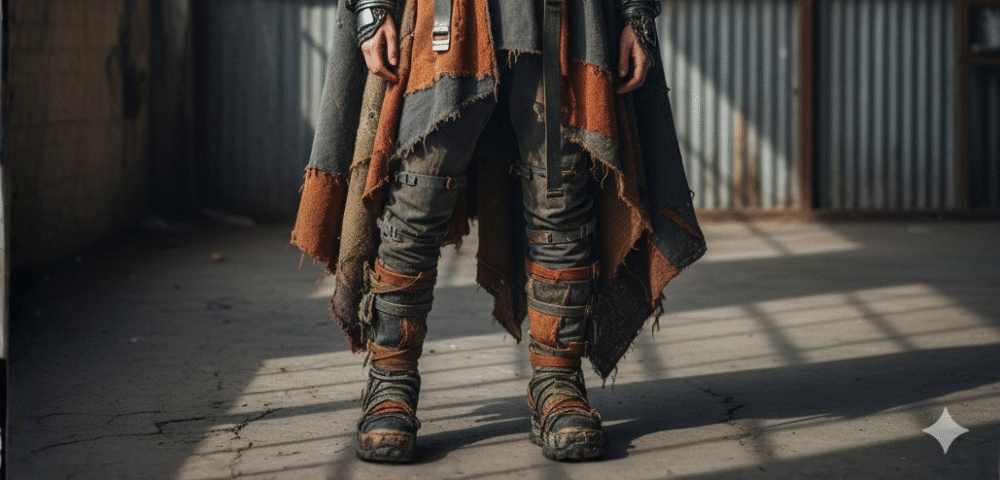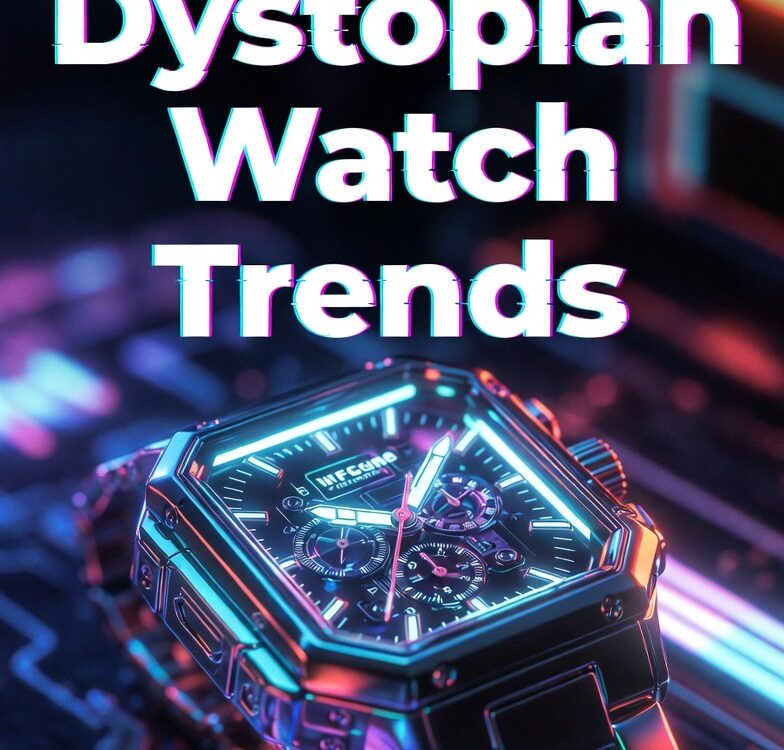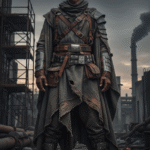
Handmade Dystopian Clothing: Embracing Futuristic Fashion in a Sustainable Way
October 16, 2025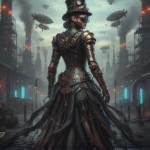
Gears of Oppression: Exploring the Steampunk Dystopian Mix
October 18, 2025In a world increasingly aware of environmental crises, fashion is evolving to reflect both our fears and our hopes for the future. Enter recycled dystopian fashion—a bold fusion of gritty, futuristic aesthetics inspired by sci-fi worlds like those in Mad Max or Blade Runner, reimagined through sustainable practices. This trend isn’t just about looking like a survivor in a wasteland; it’s about actually surviving by repurposing materials that would otherwise end up in landfills. As climate change looms large, designers and everyday fashion enthusiasts are turning to upcycled fabrics, recycled plastics, and salvaged hardware to create outfits that scream rebellion while whispering eco-consciousness.
The appeal of recycled dystopian fashion lies in its duality: it’s edgy and utilitarian, yet profoundly ethical. Imagine a jacket pieced together from old leather scraps and discarded tech components, evoking a post-apocalyptic warrior ready to navigate urban ruins. This style has gained traction in recent years, fueled by social media platforms where creators share DIY tutorials and high-end runways showcase collections that prioritize sustainability. From cyberpunk influences to wasteland vibes, recycled dystopian fashion allows wearers to make a statement about consumerism, waste, and resilience. In this article, we’ll dive into its origins, key elements, styling tips, and why it’s more than a fleeting trend—it’s a movement toward a greener tomorrow.
The Origins of Dystopian Fashion
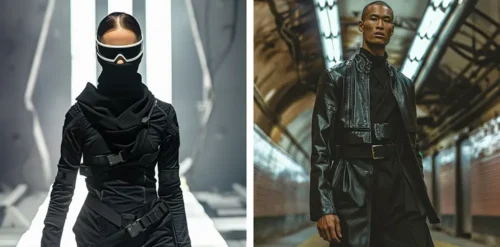
Dystopian fashion draws heavily from cinematic visions of bleak futures, where society has crumbled under oppression, environmental disaster, or technological overreach. Films like Blade Runner (1982) introduced sleek, neon-lit cyberpunk looks with high collars, trench coats, and metallic accents, while Mad Max: Fury Road (2015) popularized rugged, makeshift ensembles from scavenged materials. These styles often feature asymmetrical cuts, layered armor-like pieces, and a palette of blacks, grays, and earth tones to convey survival in harsh environments.
Historically, dystopian aesthetics emerged in the late 20th century amid Cold War anxieties and cyberpunk literature. Designers like Vivienne Westwood and Jean Paul Gaultier incorporated punk elements—ripped fabrics, safety pins, and industrial hardware—into their work, laying the groundwork for what we see today. In the 2020s, amid global pandemics and climate urgency, this fashion has resurged, with collections from brands like Chanel featuring foggy runways and distressed coats that evoke apocalyptic scenarios.
What sets modern iterations apart is the integration of recycling. Early dystopian looks relied on new synthetics like PVC and vinyl, but today’s versions emphasize upcycled alternatives. For instance, recycled leather from old jackets or neoprene from discarded wetsuits provides that tough, futuristic edge without the environmental cost. This shift mirrors broader cultural changes, where fashion isn’t just escapism but a commentary on real-world issues.
The Rise of Recycled Fashion in a Conscious World
Recycled fashion has exploded as consumers demand transparency and sustainability. The fashion industry is notorious for its waste—producing over 92 million tons of textile garbage annually—but recycling offers a lifeline. Upcycling, in particular, transforms waste into high-value items, reducing the need for virgin materials and cutting carbon emissions.
Brands like Patagonia and Stella McCartney have led the charge, using recycled polyester from plastic bottles and organic cottons. But recycled dystopian fashion takes this a step further by infusing eco-materials with narrative depth. Think patchwork pants made from old denim scraps, evoking a scavenger’s ingenuity in a dystopian landscape. Social media amplifies this, with platforms like Pinterest showcasing “dystopian hippie” boards that blend bohemian vibes with recycled elements.
The pandemic accelerated this trend, as people turned to DIY projects during lockdowns. Forums like Reddit discuss sustainable counter-culture looks, advocating for “recycled, upcycled, patchworked” clothing that rejects shiny consumerism. In essence, recycled fashion isn’t new, but its marriage to dystopian themes makes it relevant, turning waste into wearable art that challenges fast fashion’s disposability.
Exploring the Intersection: Recycled Dystopian Fashion in Action
At the heart of recycled dystopian fashion is creativity born from constraint. Designers repurpose everyday waste into statement pieces: old tires become belts, circuit boards adorn vests, and plastic bottles are spun into threads for cargo pants. This approach not only reduces waste but also embodies the dystopian ethos of resourcefulness in scarcity.
Notable examples include indie creators like Hillary of Stone Crow Studios, who crafts one-of-a-kind garments from upcycled fabrics inspired by dark fantasy and dystopian worlds. Her pieces, such as patched cloaks and armored jackets, are handmade and unique, appealing to those seeking authenticity. On Etsy, sellers offer custom dystopian clothing from recycled materials, like wasteland scarves and cyberpunk hoodies.
High fashion isn’t far behind. Collections from Techwear Storm feature dystopian clothes with recycled elements, including cyberpunk jackets and wasteland pants. Runway shows, such as Deadwood’s 2024 Spring/Summer line, highlight upcycled leather and patchwork in desert-dystopian themes. Even mainstream influences, like costumes from Dune or Aliens, inspire recycled versions shared on Reddit.
This intersection promotes circular economies, where old garments are deconstructed and reborn. It’s a rebellion against overconsumption, proving that style can be sustainable without sacrificing edge.
Key Elements and Styling Tips for Recycled Dystopian Fashion
To embrace recycled dystopian fashion, focus on core elements: layering, utility, and texture. Start with base layers like distressed tees from thrift stores, then add upcycled accessories—think belts from recycled rubber or bags from old canvases.
Color palettes lean toward muted tones: blacks, olives, and rusts for that weathered look. Materials include recycled denim for pants, upcycled leather for jackets, and salvaged metals for hardware. For styling, pair a patchwork coat with combat boots and a face mask made from scrap fabric—practical for both fashion and function.
DIY enthusiasts can start small: rip and sew old jeans into cargo shorts or add LED lights from e-waste for a cyberpunk glow. Online tutorials abound, making it accessible for all budgets.
Environmental and Cultural Benefits
Beyond aesthetics, recycled dystopian fashion combats the industry’s 10% contribution to global carbon emissions. By reusing materials, it minimizes water usage and pollution—recycling one ton of textiles saves 20,000 liters of water.
Culturally, it fosters mindfulness, encouraging wearers to question consumerism. In a dystopian-inspired lens, it’s a form of activism, symbolizing hope amid despair.
Future Trends in Recycled Dystopian Fashion
Looking ahead, expect tech integration: smart fabrics from recycled e-waste, like solar-powered jackets. As AI influences design, personalized upcycled pieces could become norm. Sustainability mandates will push more brands toward this style, blending dystopia with optimism for a solarpunk future.
FAQs
What is recycled dystopian fashion?
It’s a style that combines post-apocalyptic aesthetics with sustainable, upcycled materials, creating edgy outfits from waste.
How can I start incorporating recycled dystopian fashion into my wardrobe?
Begin with thrift shopping, DIY upcycling, or buying from eco-brands like those on Etsy.
Are there affordable options for recycled dystopian clothing?
Yes, platforms like Pinterest and Reddit offer budget-friendly ideas, focusing on repurposed items.
What materials are commonly used?
Recycled leather, plastics, denim, and metals, often patchworked for a rugged look.
Is this trend environmentally friendly?
Absolutely—it reduces waste and promotes circular fashion practices.
Can recycled dystopian fashion be worn daily?
Yes, tone it down with subtle layers for everyday wear, or go full-out for events.
Where can I find inspiration?
Movies like Blade Runner, social media, and fashion weeks showcasing sustainable lines.
Final Words
Recycled dystopian fashion isn’t just clothing; it’s a manifesto for a sustainable future wrapped in futuristic grit. By embracing this trend, we honor creativity, combat waste, and envision a world where style and stewardship coexist. Whether you’re a designer or a casual enthusiast, dive in—your wardrobe, and the planet, will thank you.


